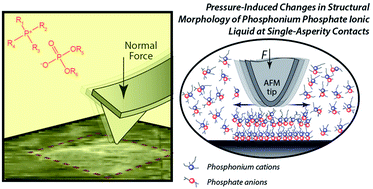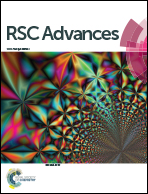In situ nanoscale evaluation of pressure-induced changes in structural morphology of phosphonium phosphate ionic liquid at single-asperity contacts†
Abstract
In this work, we perform atomic force microscopy (AFM) experiments to evaluate in situ the dependence of the structural morphology of trihexyltetradecylphosphonium bis(2-ethylhexyl) phosphate ([P6,6,6,14][DEHP]) ionic liquid (IL) on applied pressure. The experimental results obtained upon sliding a diamond-like-carbon-coated silicon AFM tip on mechanically polished steel at an applied pressure up to 5.5 ± 0.3 GPa indicate a structural transition of confined [P6,6,6,14][DEHP] molecules. This pressure-induced morphological change of [P6,6,6,14][DEHP] IL leads to the generation of a lubricious, solid-like interfacial layer, whose growth rate increases with applied pressure and temperature. The structural variation of [P6,6,6,14][DEHP] IL is proposed to derive from the well-ordered layering of the polar groups of ions separated by the apolar tails. These results not only shed new light on the structural organization of phosphonium-based ILs under elevated pressure, but also provide novel insights into the normal pressure-dependent lubrication mechanisms of ILs in general.



 Please wait while we load your content...
Please wait while we load your content...